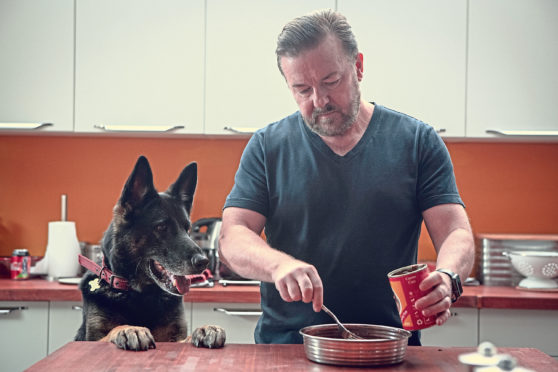
Ricky Gervais knows full well that some people might be offended by his comedy. But the Reading-born star, famous for hit shows such as The Office, Derek and Extras, is never going to filter himself – especially when performing on stage.
“If you don’t like it, you can leave,” the 58-year-old says matter-of-factly.
“I’ve not broken the law. I warn people. I played for 800,000 people – not one complained.
“I could take every bad bit out and put that out, and I’d get as many complaints, because they’ll find something.
“The cleaner and nicer you get, the less you have left, and they’ll still find it.
“You can’t make a joke that someone, somewhere, won’t find offensive, so you shouldn’t try.”
That’s where the idea for Gervais’ most recent series – dark comedy After Life – came from.
The Netflix show, which is about to return for a second run, follows journalist Tony (played by Gervais), who is suicidal following the death of his wife, Lisa (Kerry Godliman).
With only his pet dog to live for, Tony says and does whatever he wants, as he no longer cares what happens to him.
“I didn’t want to make it a vigilante thing; I wanted it to be real and I wanted it to be a comedy,” explains Gervais, when discussing the concept.
“So, I thought, ‘You could say what you want’.
“And that came with the beginning of people trying to close down on free speech, and, ‘You shouldn’t offend anyone’.
“So, I thought, ‘That’s perfect. I can create a character that can say all the things that polite people are afraid to say – he’s got nothing to lose’. He can’t be threatened by human resources, ’cos he goes, ‘I’ll kill myself’.”
In series two, we see Tony decide to try to become a better friend and colleague, when he realises everyone is grappling with their own problems – especially after learning the Tambury Gazette, where he works, faces possible closure.
Gervais found writing about Tony a cathartic process.
“I think that’s where the comedy came, actually,” he said. “Even though it was dark, and I wanted people to feel sorry for him and I wanted it to be real, I mean, to start a sitcom with a woman in chemo leaving a message and you know she’s dead – that’s not Terry and June.
“But that’s what also makes you want to root for this man who’s nasty to everyone – even kids.”
Gervais is active on Twitter, and has to deal with his fair share of trolls.
“People used to insult me, and I used to slam them, and they used to go, ‘Oh, cheers, I just got insulted by Ricky Gervais – my hero’,” he said.
“And I think, ‘Why would you do that? If I’m your hero, wouldn’t you rather I thought you were a good bloke?!’ It’s so weird!”
After Life season two, Netflix, from Friday

Enjoy the convenience of having The Sunday Post delivered as a digital ePaper straight to your smartphone, tablet or computer.
Subscribe for only £5.49 a month and enjoy all the benefits of the printed paper as a digital replica.
Subscribe